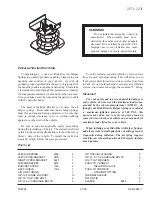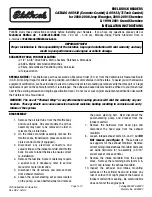
speed. Always cruise at a safe speed
based on road conditions and applicable
speed limits.
Changing the Set Speed
To change the set speed while using Traffic-
Aware Cruise Control, move the cruise control
lever up (increase) or down (decrease) until
your desired set speed is displayed.
To increase/decrease speed by 1 mph (1
km/h), move the lever up or down to the first
position and release. To increase/decrease
speed to the closest 5 mph (5 km/h)
increment, move the lever up/down to the
second position and release. For example, if
you are traveling at 57 mph and you move the
lever up to the second position and release,
the speed increases to 60 mph. You can also
increase/decrease speed by holding the lever
in the full up/down position and releasing
when the desired speed displays below the
cruise control icon.
To cruise at the speed limit that is currently
being determined by Speed Assist (including
any offsets that you have set), pull the cruise
control lever toward you. See
on
page 97.
Note:
It may take a few seconds for Model S
to reach the new cruising speed, assuming
Model S does not detect a vehicle ahead
driving slower than your set speed.
Overtake Acceleration
When following a vehicle with Traffic-Aware
Cruise Control active, briefly engaging the
turn signal (to indicate a move into the
passing lane) accelerates Model S towards the
vehicle ahead. By momentarily holding the
turn signal lever up or down, you can quickly
accelerate up to your set speed without
having to press the accelerator pedal. The turn
signal accelerates only when the following
conditions are met:
•
Traffic-Aware Cruise Control is operating
and detects a vehicle in front of you.
•
No obstacles or vehicles are detected in
the target lane.
•
Model S is traveling below the set speed,
but over 45 mph (72 km/h).
Overtake Acceleration is intended as an aid
when passing a vehicle ahead of you. When
the turn signal is engaged, Traffic-Aware
Cruise Control continues to maintain distance
from the vehicle ahead, but allows you to drive
slightly closer than your selected distance.
Acceleration cancels when:
•
You reach your set cruising speed.
•
Changing lanes takes too long.
•
Model S gets too close to the vehicle
ahead.
OR
•
You disengage the turn signal.
Note:
Overtake Acceleration occurs when you
either fully engage the turn signal, or you hold
the turn signal in the momentary position
(partially engaged). When you release or
disengage the turn signal, Model S stops
accelerating (in the same way as when you
release the accelerator pedal) and resumes
the set speed.
Warning:
Overtake Acceleration can
cancel for many unforeseen reasons in
addition to those listed above (for
example, lack of GPS data). Stay alert and
never depend on Overtake Acceleration
to increase your driving speed.
Warning:
Overtake Acceleration increases
your driving speed whenever the
appropriate turn signal is engaged, and
accelerates Model S closer to the vehicle
ahead. Although Traffic-Aware Cruise
Control continues to maintain distance
from the vehicle ahead, it is important to
be aware that your selected following
distance is reduced when Overtake
Acceleration is active, particularly in cases
Traffic-Aware Cruise Control
Driver Assistance
79
Summary of Contents for S 2017
Page 1: ...MODEL S OWNER S MANUAL...
Page 101: ...Touchscreen Overview 100 Model S Owner s Manual...
Page 195: ......
















































